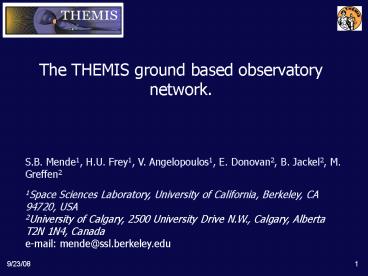The THEMIS ground based observatory network. - PowerPoint PPT Presentation
Title: The THEMIS ground based observatory network.
1
The THEMIS ground based observatory network.
S.B. Mende1, H.U. Frey1, V. Angelopoulos1, E.
Donovan2, B. Jackel2, M. Greffen21Space
Sciences Laboratory, University of California,
Berkeley, CA 94720, USA2University of Calgary,
2500 University Drive N.W., Calgary, Alberta T2N
1N4, Canadae-mail mende_at_ssl.berkeley.edu
2
Outline Brief introduction to THEMIS and the
THEMIS Ground Based Observatory (GBO) All Sky
Imager (ASI) and magnetormeter (MAG)
network. Example of the THEMIS GBO network
operation. Discussion of future plans.
3
THEMIS Primary Science
Onset and evolution of the macro scale substorm
instability
4
Aurora
Current disruption
Reconnection
2 day orbit
4 day orbit
1 day orbit
- Magnetospheric substorms are responsible for
auroral eruptions.
5
Global imaging of the aurora is a powerful
technique. (ISIS, DE-1,POLAR, IMAGE) Substorm
onsets can be timed and located from global
images taken from high altitude satellites.
Without global auroral imaging ground based
observatories are used. THEMIS GBOs A synoptic
view of the aurora with high time and spatial
resolution.
IMAGE FUV produced global images.
6
Map view with the GBO-s and THEMIS magnetometers
superposed (-now 2008).
7
Magnetometer Time resolution 1/2
sec Sensitivity 0.1 nT All sky imagers
Cadence 3 sec Resolution 256 x 256
Calibration geometry and intensity Good star
fields Geophysical interpretation Total energy
of precipitation.
8
Modeled camera white light response in
equivalent kR based on the typical camera
wavelength response for different atmospheric
conditions. Electron energy 0.5 keV (Maxwellian),
5 and 10 keV (monoenergetic) auroral
precipitation spectrum.
9
(No Transcript)
10
(No Transcript)
11
http//themis.ssl.berkeley.edu/gbo/display.py
12
(No Transcript)
13
As it was during 2007 - 2008
14
As it will be during 2009 - 2010
15
- THEMIS GBO winter schedule
- 2008-2009. Routine THEMIS operation with low
latitude substorm monitoring (Central Canada OK.
THB at midnight February 11) - Summer THB and THC become near lunar monitors
- 2009-2010 Routine THEMIS operation with higher
latitude phenomena in focus (Eastern Canada and
Greenland (THD at midnight on April 12 at
0400UT) - 2010-2011 (THD at midnight on May 10 at 2000UT)
- 2011-2012 THEMIS related work is completed.
16
THEMIS B at 29.5 Re distance responds to each
substorm onset.
17
Optical energy release
3.Structuring/new arc
4. Poleward exp/ energy release
2. Arc intensif.
1.Arc fading
18
Summary of auroral effects. What is onset?
- Arc Fading
- Arc intensif.
- Electrojet intensification
- Structuring/ new arc
- Alfvenic aurora no current return
- Pc1 generation.
- Poleward expansion and large scale brightening/
energy release conversion of magnetic energy in
near tail - Magnetospheric return current (electrojet
current wedge)
19
Example 2. Ground based observation of satellite
overpass.
What do WAE aurorae look like?
20
Dynamic rayed arc aurora. Not an arc.
21
Large auroral observatory network Array is in
place - no new equipment or infra- structure
costs. Canada is willing to support 16 out of the
21 stations. What is needed? Need site
maintenance, utilities, custodian, consumables at
5 sites (5-10 k per yr per site). Need data
center to provide accessible storage of 20
Tbytes of data per year ( 1 FTE/year).

